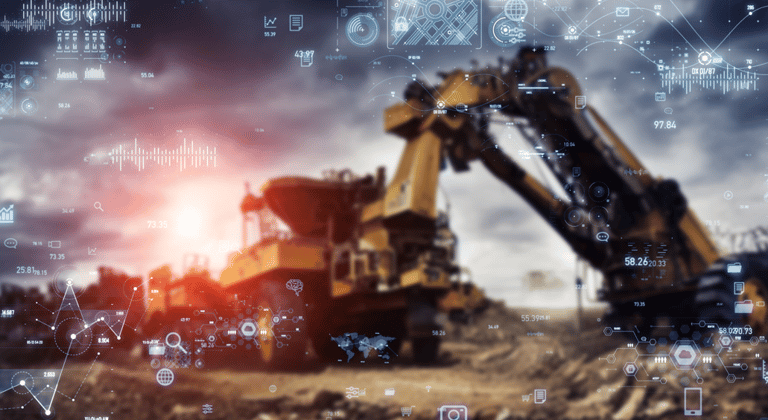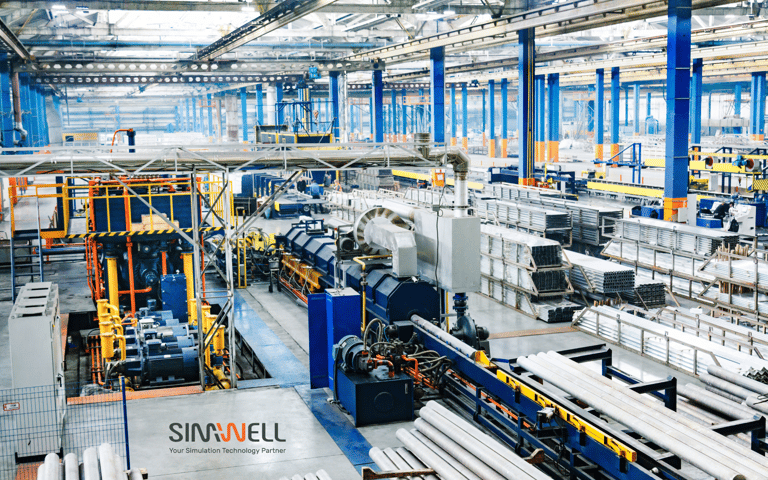Overview
The steel manufacturing industry stands on the precipice of a technological revolution propelled by advancements in artificial intelligence (AI) and machine learning. A particularly exciting application of these technologies is in optimizing the operations of material handling systems, such as cranes in steel manufacturing plants.
This article delves into the intricacies of using a simulation model to train an AI model through reinforcement learning (RL) so that it can efficiently manage a manufacturing system comprised of two or more cranes sharing the same rail.

The Challenge
In steel manufacturing, the material flow is a critical component of the production process. It involves the movement of raw materials, semi-finished products, and finished products throughout the plant.
The use of cranes, especially in environments where multiple cranes share the same rail, introduces a complex problem of coordination and efficiency.
The cranes must operate in harmony, avoiding collisions while optimizing the material flow for speed and efficiency. Currently, most steel plants have expert operators who make this decision. In a few steel plants, a static optimization-based solution is being used.
This is where AI, powered by reinforcement learning, comes into play. With an AI-based solution, you are not dependent on the expertise of a skilled operator. Because the AI model learns a control policy, it also overcomes the limitations of static optimization
Simulation Models: The Training Grounds
Before an AI model can take control in a real-world scenario, it must first learn. However, learning through trial and error in a live manufacturing environment can be impractical and hazardous. This is where simulation models offer a solution.
These models provide a virtual replica of the manufacturing system, complete with cranes, rails, and material flow dynamics. Within this controlled environment, an AI model can experiment, make mistakes, learn, and improve without any risk to actual production or safety.
Reinforcement Learning: The Learning Mechanism
Reinforcement learning, a type of machine learning, is akin to teaching a child through a system of rewards and punishments. In the context of our steel manufacturing scenario, the AI receives rewards for actions that improve efficiency (such as reducing material handling time or energy consumption) and penalties for undesirable actions (such as causing delays or potential collisions.)
The AI model, initially ignorant of how to operate the cranes, begins by making random movements. Over time, guided by the feedback from the simulation environment, it identifies patterns and strategies that yield better outcomes. This process of exploration and exploitation gradually hones the AI model's ability to manage the cranes effectively.
One of the main advantages of RL is that it can consider the temporal relation in a feedback system. An action taken now may only yield a reward after multiple time steps. Designing a system that can learn using RL involves defining appropriate system states, action matrices, and reward shaping.

Reinforcement Learning: Where it Excels
In general, an RL-based approach will outperform an optimization-based approach or heuristic in problems where one or more of the following elements are present:
-
Fuzzy problems where human operators make decisions based on years of experience but are unable to explain the exact approach they use.
-
Variation in the system and multiple feedback loops.
-
The solution search space is huge.
-
There are multiple goals that may change over time based on factors outside of control.
-
There are many challenges in the steel industry where all of the above elements are present.
Key Considerations
-
Model Accuracy: The success of this training approach hinges on the fidelity of the simulation model. It must reflect the physical and operational constraints of the actual manufacturing system, including the behavior of the cranes, the characteristics of the materials being moved, and the layout of the plant in sufficient detail.
-
Algorithm Design: The design of the reinforcement learning algorithm is crucial. It must balance the exploration of new strategies with the exploitation of known efficient methods. Moreover, the algorithm should be capable of handling the complexities of a multi-agent system, where the actions of one crane can impact the performance of the other.
-
Scalability and Adaptation: The trained AI system must not only excel in the current environment but also adapt to the evolving conditions of a manufacturing plant. This includes changes in production volumes, material types, and even modifications to the plant layout.
The Future is Now
The integration of AI into operational manufacturing systems represents a monumental leap forward in industrial efficiency and safety. By training an AI model using reinforcement learning within a simulation model, companies can ensure that their cranes and other material handling systems are optimized for the unique challenges of steel manufacturing.
This not only reduces operational costs but also enhances productivity, propelling the steel manufacturing industry into a new era of technological advancement and innovation.
The potential for AI in industrial applications is limitless. The journey from simulation models to operational mastery is a complex but rewarding endeavor, promising a future where humans and machines work in harmony to achieve unprecedented levels of efficiency and productivity in steel manufacturing and beyond.
About SimWell
SimWell Consulting and Technologies is a global company specializing simulation, optimization, and digital twin technology. Our core mission is to unlock simulation at scale. We empower leaders and operators to maximize their current resources, optimize their operations, and elevate their performance with simulation. We build models of our customers operation, test scenarios, and predict how it will perform in a risk-free environment.
With SimWell as your partner, your team will have the tools to make confident decisions, optimize your process, and press fast forward on your business.
Written by:
Amit Kumar, Director, India Operations at SimWell
OR send me a note at akumar@simwell.io







